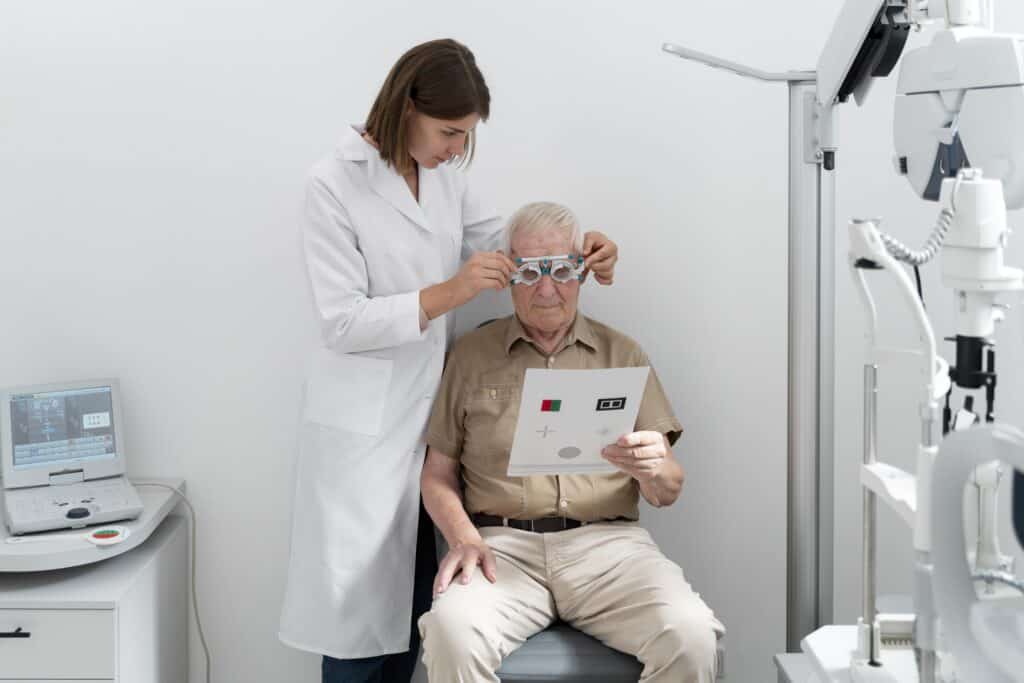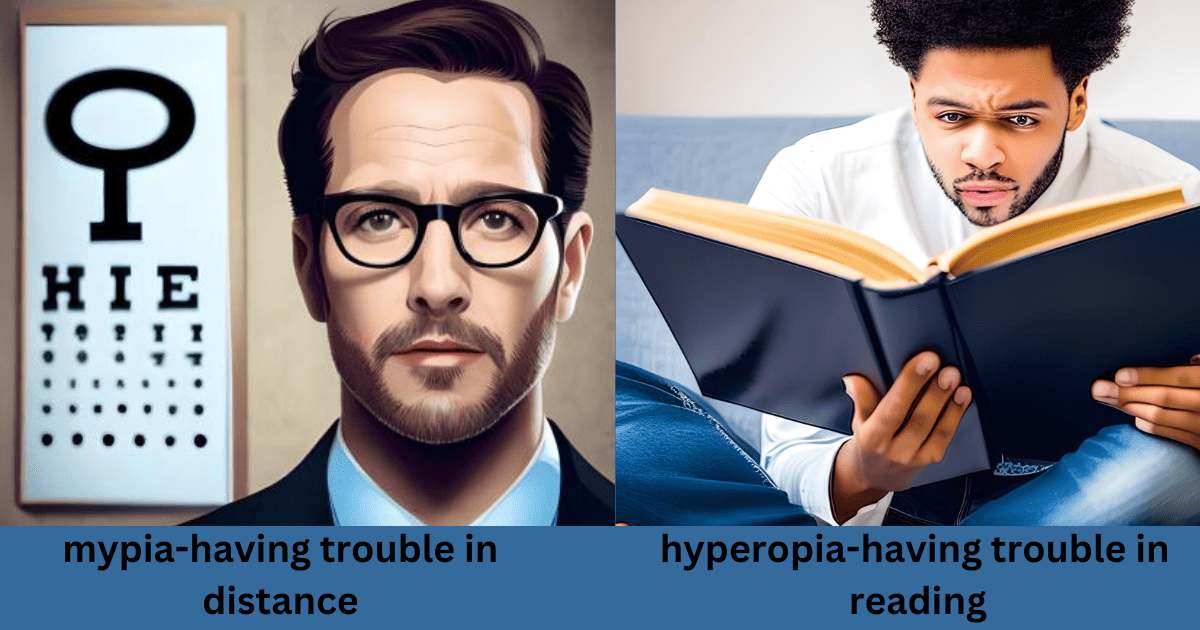Myopia vs hyperopia : Importance of understanding myopia and hyperopia
Vision problems can have a significant impact on our daily lives, hindering our ability to perform simple tasks and enjoy activities.
Two common vision conditions that affect a large segment of the population are myopia and hyperopia. Understanding these conditions and their differences can empower individuals to seek appropriate treatment options and maintain good eye health.
Understanding Normal Vision
Anatomy of the eye
Functioning of a healthy eye
Before delving into myopia(nearsightedness) and hypemetropia (farsightedness), it is crucial to grasp the basics of normal vision. The eye, a marvel of biological engineering, comprises various components working harmoniously.
The cornea, lens, iris, and retina all play essential roles in focusing light onto the retina, the light-sensitive tissue at the back of the eye. In a healthy eye, these components work together seamlessly, allowing clear and sharp vision.
Myopia: The Nearsightedness Epidemic

Definition and prevalence of myopia
Causes and contributing factors
Genetic factors and hereditary influences
Environmental factors such as increased near-work and less outdoor time
Myopia, commonly known as nearsightedness, has reached epidemic proportions in recent years. It is estimated that nearly 30% of the global population is affected by myopia. This condition occurs when the eyeball is too long, causing light to focus in front of the retina, resulting in blurred vision for distant objects.
While there is a hereditary component to myopia, environmental factors also play a significant role. Increased near-work activities, such as reading or using electronic devices, and reduced time spent outdoors contribute to the development and progression of myopia.
Hyperopia: The Farsightedness Phenomenon

Definition and prevalence of hypermetropia
Causes and contributing factors
Anatomical variations in the eye
Aging and its effect on farsightedness
Hyperopia, commonly referred to as farsightedness, is another prevalent vision problem worldwide. Approximately 25% of adults are affected by hyperopia.
Unlike myopia, hypermtropia occurs when the eyeball is shorter than normal or the cornea is flatter, causing light to focus behind the retina. As a result, near objects may appear blurred, while distant objects remain relatively clear. Anatomical variations in the eye and the natural aging process contribute to the development and progression of hyperopia.
Myopia vs Hyperopia: Key Differences and Similarities
Refractive errors and their impact
Differences in focal points and image formation
Similarities in potential vision problems and complications
While both myopia and hyperopia are refractive errors that affect the eye’s ability to focus light, they differ in how light is refracted and where the focal point falls.
In myopia, due to the elongated shape of the eyeball, light rays converge in front of the retina, resulting in a blurred image for distant objects. Conversely, with hyperopia, the shorter eyeball or flatter cornea causes light rays to converge behind the retina, leading to blurred vision for near objects.
Despite these differences, both conditions can be associated with various vision problems and potential complications, emphasizing the importance of timely intervention and management
Symptoms and Warning Signs
Common symptoms of myopia
Common symptoms of hyperopia
Identifying potential vision issues in children and adults
Recognizing the signs and symptoms of myopia or hyperopia is crucial for early detection and intervention.
Myopia often manifests as difficulty seeing distant objects, squinting, and eyestrain, especially during activities like driving or watching television.
On the other hand, hyperopia may present with blurry vision for near objects, eyestrain when performing close-up tasks, and headaches. Identifying these symptoms in both children and adults is essential to address potential vision issues and ensure proper eye care.
Complications and Associated Risks
Myopia-related complications
Increased risk of eye diseases and retinal detachment
Degenerative changes in the eye
Hyperopia-related complications
Strain on the eyes and associated discomfort
Increased risk of developing crossed eyes (strabismus)
If left unmanaged, myopia and hyperopia can lead to certain complications and associated risks. Myopia, particularly high myopia, increases the risk of developing eye diseases such as glaucoma, cataracts, and retinal detachment. It can also result in degenerative changes in the eye, potentially leading to permanent vision loss. Hyperopia, on the other hand, can cause eye strain, discomfort, and headaches due to constant focusing efforts. In some cases, untreated hyperopia can contribute to the development of crossed eyes, medically known as strabismus.
Diagnosis and Examination
Vision screening techniques
Comprehensive eye exams for accurate diagnosis
Role of optometrists and ophthalmologists
Diagnosing myopia or hyperopia requires a thorough examination of the eye’s refractive error. Vision screening techniques, such as visual acuity tests, can provide preliminary indications of a potential problem. However, comprehensive eye exams conducted by optometrists and ophthalmologists are crucial for accurate diagnosis.
These exams involve a variety of tests, including a detailed evaluation of refractive errors, visual field assessments, and assessments of eye health. Seeking professional eye care is vital to determine the exact nature and severity of the refractive error and to explore appropriate treatment options.
Treatment Options for Myopia
Eyeglasses and contact lenses
Orthokeratology (Ortho-K)
Laser-assisted procedures (LASIK, PRK)
Vision therapy and eye exercises
Lifestyle modifications and preventative measures
Various treatment options are available to correct and manage myopia, depending on its severity and an individual’s needs.
Eyeglasses and contact lenses are commonly prescribed to provide clear vision. Orthokeratology, a non-surgical procedure involving the use of specialized contact lenses, temporarily reshapes the cornea to reduce myopia during sleep.
Laser-assisted procedures like LASIK or PRK can permanently reshape the cornea, providing long-term vision correction. Vision therapy and eye exercises may be recommended to improve visual skills and reduce the strain associated with myopia.
Additionally, lifestyle modifications such as reducing near-work activities and spending more time outdoors can contribute to managing myopia’s progression.
Treatment Options for Hyperopia
Eyeglasses and contact lenses
Refractive surgeries including LASIK, PRK, and others
Hyperopia can also be effectively managed through various treatment options, aiming to provide clearer vision for near objects.
Eyeglasses and contact lenses with appropriate prescriptions can compensate for the refractive error and help individuals see clearly.
Refractive surgeries, including LASIK, PRK, and other similar procedures, can reshape the cornea, enabling light to focus properly on the retina. These surgical interventions offer a long-lasting solution and often eliminate the need for corrective lenses.
Addressing Myopia and Hyperopia in Children
Importance of early detection and intervention
Controlling myopia progression in children
Corneal reshaping techniques
Pharmacological interventions
Hyperopia and its impact on children’s vision development
Recognizing and addressing myopia and hyperopia in children is critical for their visual well-being and overall development.
Early detection through regular eye exams allows timely intervention to prevent the progression of these refractive errors.
Various methods, such as corneal reshaping techniques utilizing specialized contact lenses, may be employed to manage myopia and slow its progression. In some cases, pharmacological interventions may also be considered.
Hyperopia in children can impact their visual development, including difficulties in reading and learning. Therefore, identifying and treating hyperopia is equally important to ensure optimal vision during their formative years.
Contact Lenses: Myopia Control and Correction
Soft contact lenses for myopia control
Gas permeable and bifocal contact lenses for myopia and hyperopia correction
Contact lenses have revolutionized the field of vision correction, offering new possibilities for managing myopia progression and correcting refractive errors. Specifically designed soft contact lenses have shown promise in effectively slowing down myopia progression in children. These lenses work by altering the peripheral optical properties of the eye, reducing the elongation of the eyeball. Gas permeable and bifocal contact lenses, on the other hand, provide optimal vision correction for both myopia and hyperopia, addressing the specific needs of individuals.
Blue Light and Digital Eye Strain
Effects of blue light exposure on eye health
Managing digital eye strain in the era of digital devices
In our increasingly digital age, concerns regarding blue light exposure and its impact on eye health have arisen. Prolonged exposure to blue light emitted by electronic devices, such as smartphones, tablets, and computers, can cause digital eye strain. Symptoms include dry eyes, eyestrain, headaches, and blurred vision. Managing digital eye strain involves taking regular breaks from screen time, adjusting display settings, and using blue light filtering glasses or screen protectors to reduce exposure and alleviate discomfort.
Lifestyle Modifications for Vision Health
Importance of outdoor activities and sunlight exposure
Balancing near-work activities and eye breaks
Nutritional considerations for maintaining healthy vision
Maintaining good vision health extends beyond corrective measures and treatment options. Engaging in outdoor activities and exposing the eyes to natural sunlight has been associated with a reduced risk of myopia development and progression. Balancing near-work activities with periodic eye breaks allows the eyes to rest and recover from extended periods of focusing. Furthermore, incorporating a nutrient-rich diet that includes vitamins A, C, E, and omega-3 fatty acids can support healthy vision and the overall well-being of the eyes.
Addressing Myopia and Hyperopia in the Aging Population
Age-related changes in vision
Vision correction options for seniors
As we age, our eyes undergo various changes that can impact overall vision. Presbyopia, a natural age-related condition, affects the eye’s ability to focus on nearby objects and is often mistakenly associated with hyperopia. Seniors experiencing presbyopia can benefit from reading glasses or multifocal lenses that correct near and distance vision. Additionally, refractive surgeries or contact lenses may provide viable options for vision correction in older individuals, depending on their specific needs and eye health.
Future Advancements and Research
Investigating novel approaches for myopia prevention and control
Technological advancements in vision correction
The field of vision correction and eye care is continuously evolving, with ongoing research and advancements. Researchers are actively exploring novel approaches to prevent and control myopia, seeking innovative interventions beyond traditional methods. Likewise, technological advancements, such as wavefront-guided treatments and customizable contact lenses, are improving the precision and effectiveness of vision correction. These advancements hold promise for enhanced treatment options, providing individuals with clearer vision and improved quality of life.
Conclusion
Recap of key points discussed
Importance of regular eye care and seeking professional advice
In conclusion, myopia and hyperopia are common vision problems that can significantly impact our lives.
Understanding the causes, symptoms, and treatment options for these refractive errors is crucial for maintaining good eye health. Regular eye care, including comprehensive eye exams, is essential for early detection and intervention. By seeking professional advice and appropriate treatment, individuals can achieve a clearer focus, ensuring optimal vision and well-being.
Are myopia and hyperopia preventable?
While myopia and hyperopia may not be entirely preventable, certain lifestyle modifications and early intervention can help manage their progression.
Can myopia or hyperopia correct themselves over time?
Without intervention, myopia or hyperopia generally do not correct themselves over time. However, some individuals may experience slight changes in their refractive error.
Is it possible to have both myopia and hyperopia simultaneously?
It is possible to have characteristics of both myopia and hyperopia simultaneously, referred to as mixed astigmatism.
How often should one go for an eye exam?
It is recommended to have regular eye exams every one to two years, or as advised by an eye care professional, to monitor vision health and detect any changes early on.
